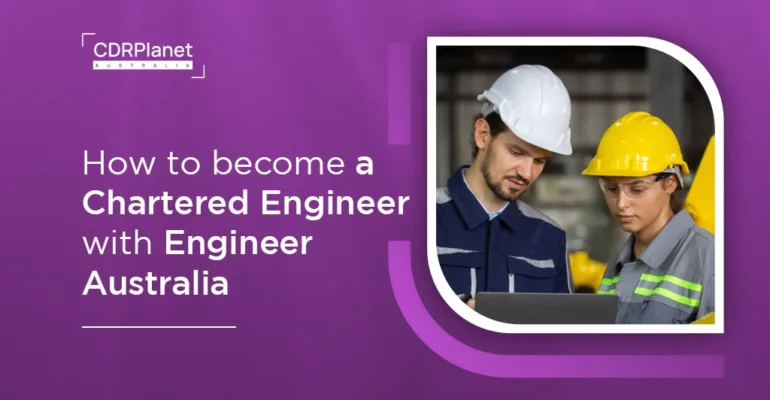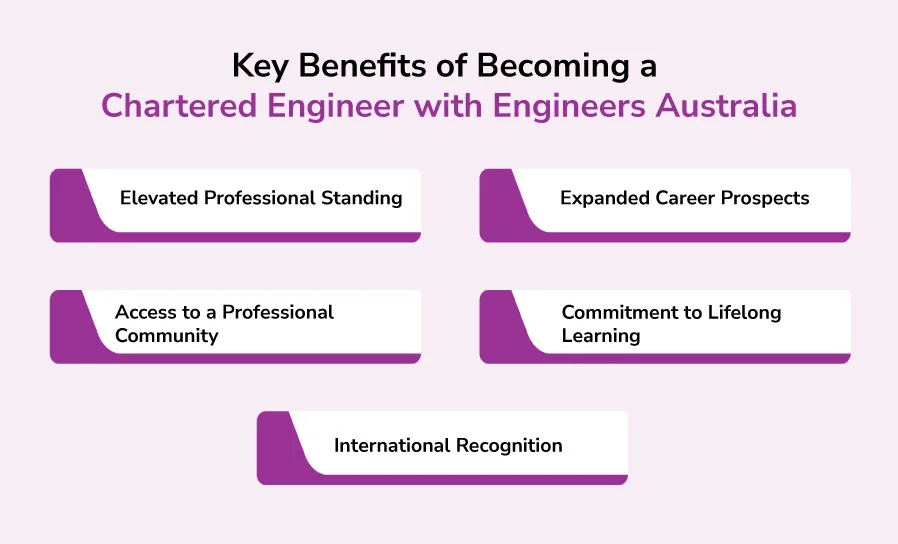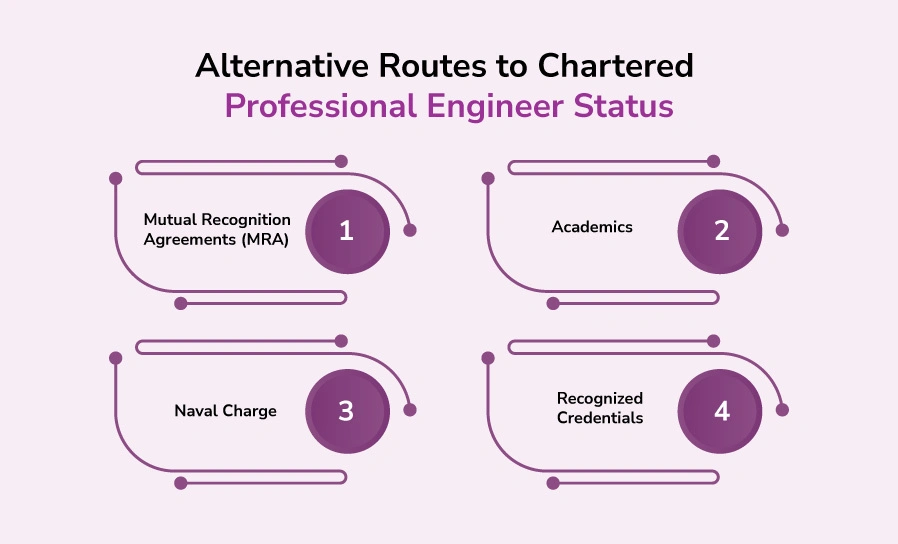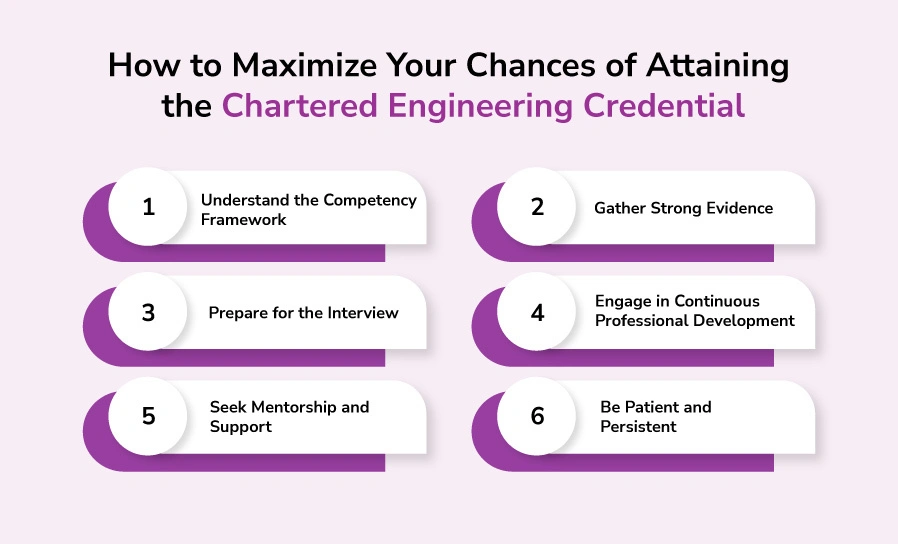How to become a Chartered Engineer with Engineer Australia

How to become a Chartered Engineer with Engineer Australia
Becoming a Chartered Professional Engineer (CPEng) with Engineers Australia is a significant milestone for your professional excellence and competency in the engineering industry.
It signifies that you have reached the highest standard of professional practice and possess the skills, knowledge, and experience to lead in your engineering discipline.
This guide provides a step-by-step process for becoming a chartered engineer, including the eligibility criteria and key benefits of achieving this esteemed status.
What is an Engineers Australia Chartered Engineer status?
A Chartered Professional Engineer (CPEng) is an individual who has proven exceptional competence, professionalism, and ethical conduct in the engineering field. A Chartered credential is a distinguished honour reflecting your commitment and engineering proficiency.
This globally respected qualification enhances your professional standing, making you a highly desirable candidate. It can lead to career advancement, leadership positions, and global opportunities.
Engineering plays a vital role in developing modern society’s infrastructure and technology. Achieving the Chartered Professional Engineer (CPEng) designation in Australia is a notable milestone for engineers aiming to excel in this ever-evolving profession.
The CPEng qualification, recognised both nationally and internationally, provides access to career growth, leadership opportunities, and the chance to contribute to impactful projects.
In this guide, we’ll cover everything you need to know about obtaining the Chartered Professional Engineer credential in Australia, including its advantages and eligibility criteria, application steps, and how it can propel your career to new levels of success.
Key Benefits of Becoming a Chartered Engineer with Engineers Australia

Before exploring the details of how to become a Chartered Engineer, it’s important to recognise the advantages that come with this prestigious designation. Here are some key benefits:
Elevated Professional Standing
Attaining the Chartered Professional Engineer (CPEng) title demonstrates that you have met the stringent standards established by Engineers Australia. This acknowledgement is highly regarded across industries and can significantly boost your professional credibility.
Expanded Career Prospects
Many employers prioritise or mandate Chartered Engineer status for their engineering staff. This credential can unlock access to senior roles, leadership opportunities, and specialised projects that may be out of reach for non-chartered engineers.
Access to a Professional Community
Becoming a Chartered Engineer grants you access to a wide network of engineering professionals. This community offers valuable resources, mentorship opportunities, and collaboration opportunities.
Commitment to Lifelong Learning
Engineers Australia places a strong emphasis on continuous growth. As a Chartered Engineer, you’ll be encouraged to participate in ongoing professional development (CPD), ensuring your skills and knowledge stay up-to-date and aligned with industry advancements.
International Recognition
The Chartered Engineer designation is acknowledged worldwide, facilitating opportunities to work overseas or collaborate with global teams. This international recognition can expand your career opportunities and open doors to new experiences.
Who is Eligible to Become a Chartered Engineer in Australia?
Chartered status with Engineers Australia requires membership, five years of engineering experience, and demonstrated competence across 16 elements within four categories: personal commitment, community obligation, workplace value, and technical proficiency.
Streamlined applications are available for experienced engineers. Holders of foreign Chartered credentials (under mutual recognition agreements) may also apply, provided they demonstrate 150+ hours of CPD in the last three years.
To become a Chartered Engineer in Australia, you must also demonstrate these qualities. Here are the qualities:
Educational Qualification
A person holding a recognised four-year engineering degree accredited by Engineers Australia. Overseas qualifications may require assessment.
Professional Experience
Must hold a minimum of 3–5 years of relevant engineering experience, including at least one year in a responsible role in Australia.
Competency Demonstration
Demonstrate your skills against the Engineers Australia Chartered Competency Framework, covering technical expertise, problem-solving, communication, and ethical practice.
Continuous Professional Development (CPD)
Show ongoing engagement in CPD through relevant courses, training, and industry events.
Ethical Standards and Membership
Adhere to Engineers Australia’s ethical guidelines and be a current member before applying for Chartered status.
The Pathways to Becoming a Chartered Engineer
To achieve Chartered Engineer status, members of Engineers Australia follow a structured six-step process.
1. Self-Assessment
Applicants begin by evaluating their skills and knowledge against Engineers Australia’s Chartered competencies.
They assess themselves on a scale from developing to advanced in the Stage 2 competencies, which vary depending on their role (professional engineers, engineering technologists, or engineering associates).
These competency standards are accessible on the Engineers Australia website.
2. Industry Review
Following the self-assessment, applicants seek feedback on their competencies from industry peers. If they are rated as “functional,” they can proceed to the next step.
Those with a “developing” rating can still proceed by gathering input from colleagues and preparing evidence. This step can be revisited at any time, as there are no strict deadlines for updates.
Who qualifies as an industry reviewer?
Reviewers must be Chartered engineers or professionals with at least seven years of engineering experience, preferably in the applicant’s field of practice.
3. Enrollment in Chartered
Applicants who achieve a functional or higher rating can enrol in the Chartered Engineer programme by paying the required fee and submitting their resume, CPD log, workplace review, and areas of expertise for which they seek Chartered status.
4. Chartered Evidence Submission
Candidates must provide evidence for the 16 competencies they assessed, adhering to Engineers Australia’s guidelines on acceptable documentation. Alongside the evidence, they submit their CV, CPD log, and Areas of Practice documents.
Any questions about the evidence are clarified after a discussion with Engineers Australia, and the final documents are reviewed within five weeks.
5. Professional Consultation
Once the evidence is approved, applicants are invited to a professional consultation, typically scheduled four weeks after the assessment.
This one-hour interview involves presenting and discussing the submitted evidence with an Engineers Australia representative and a panel of external engineers.
6. Certification
Applicants receive the outcome via email after the consultation. Successful candidates are awarded Chartered status and certification for their areas of practice.
Unsuccessful applicants receive feedback and guidance for improvement, including options to submit additional evidence or attend another interview. An appeals process is available for those who believe the decision was unfair.
Alternative Pathways to Chartered Status

In some cases, alternative routes to becoming a Chartered Engineer in Australia are available:
Mutual Recognition Agreements
If you hold a Chartered credential from an overseas engineering authority, you may be eligible for Chartered status in Australia through a mutual recognition agreement. Engineers Australia’s mutual recognition page details the application process and a list of reciprocal organisations.
Academics
If you work in an academic role at an Engineers Australia-accredited university, you may qualify to apply for Chartered status directly. Contact Engineers Australia to confirm eligibility and learn about the application process.
Naval Charge
Active members of the Australian Defence Force may also be eligible for direct application. For details on eligibility and the application process, contact Engineers Australia.
Recognised Credentials
If you hold qualifications from reputable organisations in specific areas of practice, these may be considered equivalent to Chartered status. Examples include:
- INCOSE CSEP or ESEP (systems engineering)
- AACEI CCP, PSP, EVP, or DRMP (cost engineering)
- AMC CSAM or CFAM (asset management)
Contact Engineers Australia for more information on obtaining Chartered certification based on these credentials.
National Engineering Register (NER)
In addition to Chartered status, many engineers join the National Engineering Register (NER), a public database maintained by Engineers Australia that lists competent and ethical professionals.
NER registration enhances credibility and makes it easier for clients and employers to verify qualifications.
Maintaining Chartered Status
Chartered status requires ongoing professional development. Engineers must complete at least 150 hours of CPD over three years to maintain their CPEng credentials. Common CPD activities include:
- Attending workshops, seminars, and conferences
- Completing formal education or training programs
- Participating in industry groups and committees
- Mentoring junior engineers
- Reading technical journals and industry publications
Failure to meet CPD requirements may result in the suspension or loss of Chartered status.
Learn more: 💥😎What is a CDR report?💯✅
Chartered Professional Engineer (CPEng) vs. National Engineering Register (NER)
While both CPEng and NER are respected, they serve different purposes:
- CPEng focuses on recognising competence, leadership, and ethics, offering global recognition and career advancement opportunities.
- NER is a public register that enhances visibility and credibility, often required for regulated sectors.
Many engineers pursue both to maximise career flexibility.
Costs of Becoming a Chartered Professional Engineer
The process involves several fees, including:
- Application Fee: Covers self-assessment, industry review, and evidence submission.
- Professional Consultation Fee: For the interview with a panel of Chartered engineers.
- Ongoing CPD Costs: For maintaining Chartered status through professional development activities.
- Annual Membership Fees: To retain Chartered status and NER listing.
How to Maximize Your Chances of Attaining the Chartered Engineering Credential

Achieving Chartered status is a rigorous process, but there are several steps you can take to maximise your chances of success:
1. Understand the Competency Framework
The Engineers Australia Chartered Competency Framework outlines the key competencies required for Chartered status. Familiarise yourself with this framework and ensure that your application demonstrates your competence in each of the key areas.
2. Gather Strong Evidence
Your application should include strong evidence of your competencies, experience, and professional development. This may include project reports, design documents, performance reviews, and testimonials from colleagues or supervisors. Be sure to provide detailed examples that demonstrate your skills and achievements.
3. Prepare for the Interview
The interview is a critical part of the assessment process. Prepare thoroughly by reviewing your application, practising your responses to potential questions, and being ready to discuss your experience and competencies in detail.
Consider seeking feedback from a mentor or colleague who has already achieved Chartered status.
4. Engage in Continuous Professional Development
Demonstrating a commitment to continuous professional development is essential for achieving Chartered status. Participate in relevant training, courses, and industry events, and keep a record of your CPD activities.
This will not only strengthen your application but also help you stay up-to-date with the latest advancements in your field.
5. Seek Mentorship and Support
Consider seeking mentorship from a Chartered Engineer who can provide guidance and support throughout the process.
Engineers Australia also offers resources and support to help candidates prepare for the assessment, including workshops, webinars, and online resources.
6. Be Patient and Persistent
The process of becoming a Chartered Engineer can be challenging, but it is also highly rewarding. Be patient and persistent, and don’t be discouraged by setbacks.
With dedication and hard work, you can achieve Chartered status and take your engineering career to the next level.
Editors Choice: 🧑✈️ 9 Common Mistakes in CDR Report Writing.💯🔥✈️
Conclusion
Becoming a Chartered Professional Engineer (CPEng) with Engineers Australia is a significant milestone that can elevate your career, broaden your professional network, and showcase your dedication to excellence in engineering.
By thoroughly understanding the requirements, preparing a robust application, and committing to continuous professional development, you can significantly increase your chances of earning the Chartered Engineering credential.
Whether you follow the Standard Pathway or leverage mutual recognition agreements, achieving Chartered status is a valuable investment in your future as an engineering professional.
It’s important to remember that the journey to becoming a Chartered Engineer goes beyond meeting technical competencies. It also involves demonstrating a commitment to ethical practice, sustainability, and social responsibility.
By embracing these values and consistently striving for excellence, you can make a meaningful impact in the engineering profession and contribute positively to society.
If you’re ready to take the next step in your engineering career, begin your journey towards becoming a Chartered Engineer with Engineers Australia today.
The rewards—ranging from enhanced career opportunities to global recognition—are well worth the effort. The skills, knowledge, and professional growth you gain along the way will serve you throughout your career. Best of luck to you in achieving Chartered status!
FAQs
1. How can I become Chartered in Australia?
To become Chartered, you need to demonstrate your competencies in engineering through work experience, prepare a professional portfolio, and complete the Engineers Australia Chartered assessment process.
2. Is becoming Chartered valuable for engineers in Australia?
Yes, it is highly beneficial as it enhances your professional recognition, career opportunities, and earning potential in Australia and internationally.
3. What does Chartered status represent?
Chartered status signifies that an engineer meets globally recognised standards in engineering expertise, leadership, and ethical practice.
4. Can someone with a Bachelor of Engineering (BEng) qualify?
Yes, engineers with a BEng degree and relevant work experience can pursue Chartered status with Engineers Australia.
5. What are the costs associated with becoming Chartered?
The fee for Chartered Assessment varies and includes application and assessment charges. Check the Engineers Australia website for the latest fee details.
6. Is the CPEng designation worth pursuing?
Absolutely. Chartered Professional Engineer (CPEng) status can significantly boost your career prospects, salary, and professional standing.
7. What is the typical salary of a Chartered Engineer in Australia?
Chartered Engineers often earn higher salaries compared to non-chartered peers, with average salaries depending on experience, specialisation, and location.
8. Are there age restrictions for Engineers Australia membership?
There is no upper age limit for becoming Chartered, provided you meet the eligibility and competency criteria.
9. What roles do Chartered Engineers typically perform?
Chartered engineers handle complex projects, provide technical leadership, ensure safety and sustainability, and offer expert advice in their field.
10. How challenging is the process?
Becoming Chartered requires commitment, but with proper preparation and relevant experience, it is achievable.